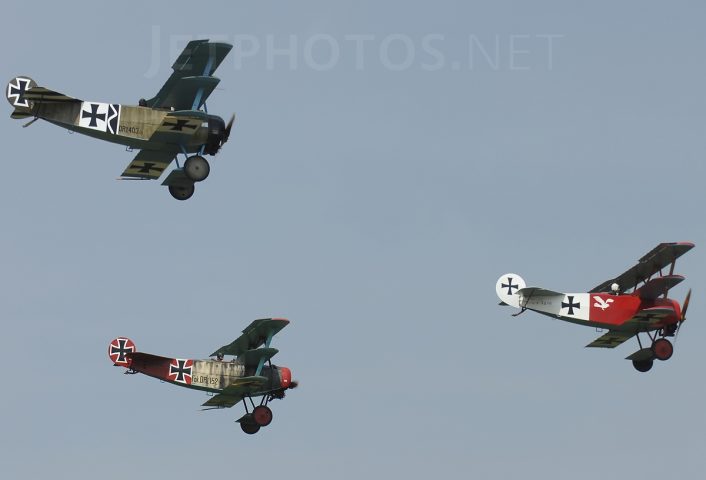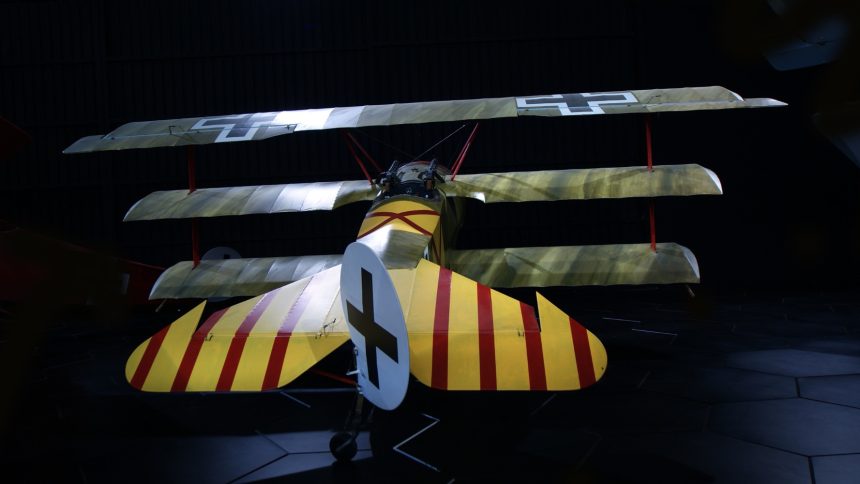Diminutive and nimble, the Fokker Dr.1 was Germany’s answer to the British Sopwith Triplane during the Great War over the skies of Europe, and was a favored mount of one of history’s most famous aces.
The Triplane Craze
When the British Sopwith Triplane made its appearance in early 1917, its performance and climb rate stunned the Germans. Built with three wings instead the more common monoplane or biplane design, the third wing gave increased climb rates and better agility, along with better pilot visibility. Flying with the RNAS (Royal Navy Air Service), one unit, designated “B” Flight of Number 10 Naval Squadron, consisted of five black-nosed Triplanes flown by Canadian pilots, and were known as “Black Flight”.
Racking up an incredible tally of over 80 aircraft shot down between May and the end of July in 1917 with minimal losses, the Sopwith Triplane definitely outclassed the planes it flew against, even when flown against the best German pilots of Jagstaffel 11 (Jasta 11). Jasta 11 was a unit led by Manfred von Richthofen, better known as “The Red Baron”. Panic over the new three-wing design set in on the German side, and the very sight of the Triplane stoked fear into the pilots pitted against it. The result was a scramble by the Germans to design and build their own triplane dogfighter. This was known as the “Triplane Craze.”
Germany and Austria-Hungary would produce several triplane models from different manufacturers as a result of this sudden interest and belief in the inherent superiority of the triplane design by the Central Powers. But only one model would stand out and be produced in number. That aircraft would be the Fokker Dr.1.
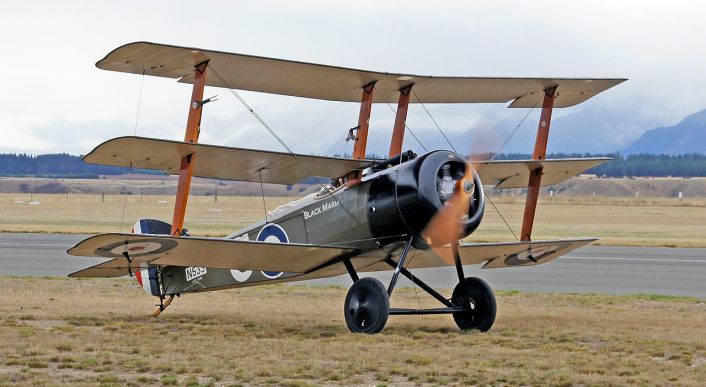
Meet the Fokker
Working for Germany, Dutch airplane maker Anthony Fokker is said to have had the first Sopwith Triplane downed in German occupied territory delivered to him for study and production of a German counterpart. Quickly designed by Reinhold Platz, the first preproduction model flew in the summer of 1917.
The prototypes were designated the Fokker F.1, and three were produced. Two saw operational service; one was flown by Werner Voss, the other Manfred von Richthofen, scoring his 60th victory in the aircraft. Voss was the second leading ace behind Richthofen at the time, and scored his last 11 kills in the F.1. Voss was a huge supporter of the type, along with other pilots that flew it. It went into production as the Fokker Dr.1 (the Dr. is the abbreviation for Dreidecker, which means triplane).
The Production Model
The horizontal tail surface shape was changed from the prototypes and skids placed under the wingtips, preventing damage in the case of ground loops. A light clean design devoid of bracing wires, the production model outflew contemporary German fighters, prompting Richthofen to declare the aircraft could “climb like a monkey and maneuver like a devil.”
Ailerons were present only on the upper wing. The light and powerful elevators and rudder allowed remarkable control had allowing it to hold a much tighter turn and gave it a remarkable yaw ability. An airfoil was placed between the wire-spoked and canvas covered wheels of the undercarriage.
The aircraft had a wood laminate propeller, made of walnut and ash wood. The laminated propeller was less prone to warpage, was lighter, less expensive to produce than solid propellers, and was stronger and more flexible. The fuselage was constructed of a revolutionary welded tubular design covered with cloth, the wings made of a wooden spar with ribs glued to it and also covered with cloth. The cockpit was sparse, with minimal necessary gauges and a basic metal seat.
The Dr.1 was powered by a single 110 horsepower Oberursel Ur.II 9-cylinder rotary engine, producing a maximum speed of 110-115 mph, and the rate of climb achieved 10,000 feet in around 7 minutes. Considering many aircraft of the day, including the Sopwith Triplane, took over 10 minutes, if not longer, to reach 10,000 ft, this was a significant improvement. Service ceiling was just over 20,000 ft. The aircraft was small, with a 23’ 7” wingspan, a length of 18’ 11”, and a height of 9’ 8”. Maximum take-off weight was 1,291 lb and empty weight was only just over 800 lbs. The aircraft had an endurance of about 1 hour and 30 minutes.
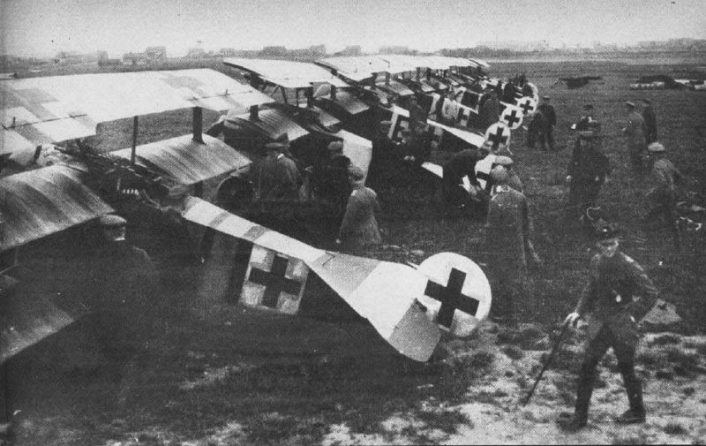
Fokker Firepower
The Dr.1 was armed with two forward-firing side-by-side LMG 08/15 “Spandau” water-cooled machine guns of Maxim design, mounted on the upper part of the forward fuselage just in front of the cockpit, firing through the propeller arc utilizing a synchronized interrupter gear. The belt-fed guns each had 500 rounds of ammunition stored behind the fuel tank and in front of the cockpit under the weapons. They fired the 7.92 mm x 57 round at 2,821 feet per second with a rate of fire of 400-500 rounds per minute. Sighting range was 2,200 yards. The control column had left and right trips mounted to it, allowing the guns to be fired individually or they could both be fired together.
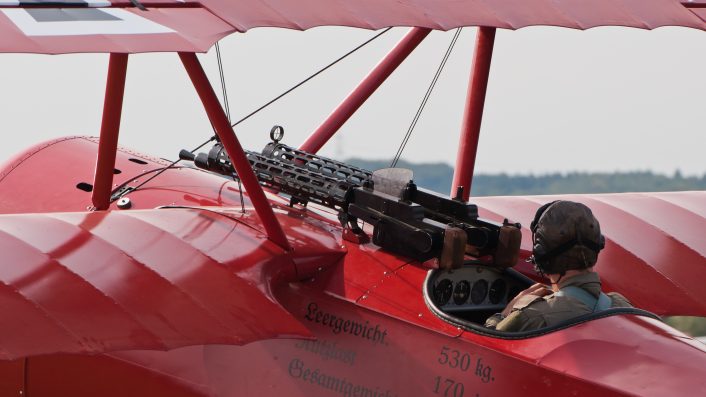
A Flying Circus
Perhaps the Fokker Dr.1 was not the best fighter of the Great War, but it is by far the most famous, and possibly the most famous of all time, simply because of who flew it. Dubbed the “Flying Circus” due to the dazzling array of bright colors and markings applied to many of their aircraft and the fact the group traveled about the front and set up camp in various locations as needed, Jagdeshwader 1 (Fighter Wing 1) was the result of reorganization efforts of the Germans placing Jastas 4, 6, 8, and 11 into the larger formation in June of 1917. Manfred von Richthofen was in overall command.
Early in 1917 Richthofen had painted his aircraft at the time, an Albatross D.III, an overall bright crimson red, and being so colorful not only did it make it a target easily spotted, it also inspired awe and respect and instilled a bit of fear in opponents. Scoring 23 kills in the Albatross D.III, he earned the moniker “The Red Baron.”
Some of Germany’s deadliest aces flew in the Circus, including Herman Göring, Ernst Udet, Werner Voss, Hans Weiss, Kurt Wolf, Manfred’s cousin Wolfram von Richthofen, and also Manfred’s brother Lothar von Richthofen. Manfred was the leading ace of the war with 80 victories to his credit.
Many of the Red Baron’s victories came in a variety of aircraft, as during the war technology was accelerated and aircraft continued to evolve at a rapid pace, and frontline fighters would often have short lifespans. But his most famous mount is the crimson red triplane we are all familiar with, the Fokker Dr.1. It would be the aircraft he preferred even after the introduction of newer and faster planes became available. In fact, the Red Baron would make his last flight in it, being killed on Apr. 21, 1918, while flying a Fokker Dr.1 designated 425/17.

The Wings Come Off
In the fall of 1917 two prominent aces, Heinrich Gontermann and Gunther Pastor, had the wings break apart on the Dr.1 and were killed within two days of each other. The seventeen aircraft in service at the time were grounded and production halted to investigate the causes. It was discovered that the wings were poorly constructed causing structural failures, and Anthony Fokker was instructed to replace the wings on the existing planes and improve the construction on those being produced.
The aircraft returned to service in November with production resuming shortly afterwards. However, problems with the upper wings continued into 1918. This issue, coupled with the aircraft’s tricky handling challenging inexperienced pilots, and the fact the three wings increased drag and decreased speed, lead to the short lifespan of this remarkable plane and frontline service being pretty much over by the summer of 1918.
A total of 320 had been built, and the type is credited for over 600 aerial victories. For such an iconic aircraft, there are no surviving original complete Fokker Dr.1s in existence. One of Manfred von Richthofen’s Dr.1s was on display at the Zeughaus museum in Berlin but destroyed during bombing raids in World War Two. Now only fragments remain scattered throughout the world in various museums and private collections along with replicas of a once feared and beautiful aircraft.
